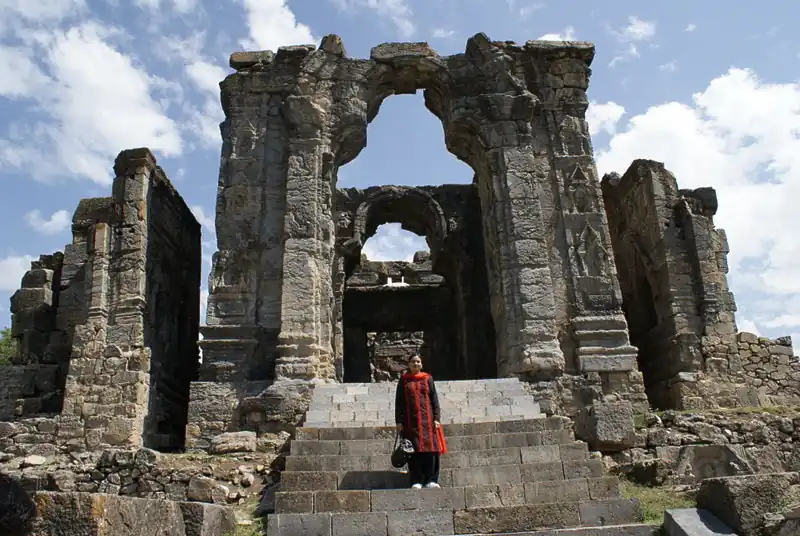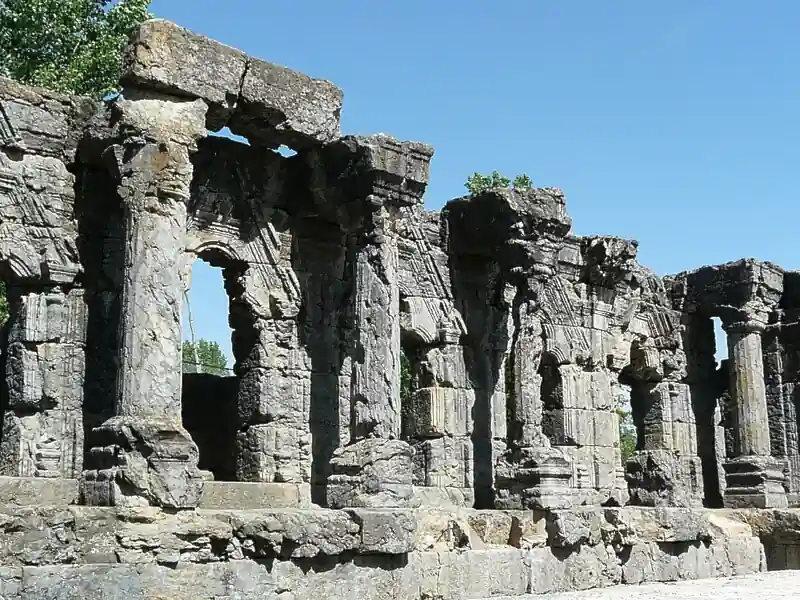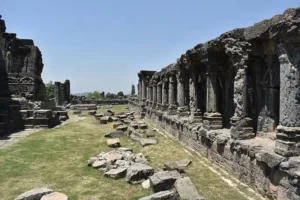The Martand Sun Temple found close to Anantnag in the beautiful Kashmir Valley, is an important historical site and an amazing piece of architecture dedicated to Surya, the Hindu god of the sun. Built-in the 8th century CE, this temple showcases the rich cultural history of India and the incredible skills of the Karkota dynasty.
As we dive into the temple’s history, stunning design, and the meanings behind its features, you’ll see why the Martand Sun Temple is such a valuable part of Kashmiri culture. Come along with us on this adventure through time, stories, and beauty as we explore the many aspects of this remarkable monument.

Geographical Setting and Location
The Martand Sun Temple is found in the beautiful Kashmir Valley, perched on a plateau that offers amazing views of the area. It is located around 9 kilometers from Anantnag and is easily accessible by road, surrounded by picturesque scenery.
The location was probably selected to represent the Sun God’s dominance over the valley, allowing sunlight to shine on it all day long. Visitors can have a peaceful experience, enjoying the blend of nature and architecture, making it a top spot for anyone interested in Kashmir’s vibrant culture and history.
History and Legend of Martand Sun Temple
The Martand Sun Temple, located near the city of Anantnag in Jammu and Kashmir, India, is one of the most significant and ancient Hindu temples dedicated to the Sun God, Surya. This temple, also known as the Martand Temple, has a rich history that dates back to the 8th century CE.
Foundation and Construction
The Martand Sun Temple was built by Lalitaditya Muktapida, a ruler of the Karkota Dynasty, during the 8th century CE. Lalitaditya was known for his military conquests and his patronage of art and architecture. The temple was constructed on a plateau, offering a panoramic view of the beautiful Kashmir Valley. The site was chosen for its strategic and scenic location, which added to the temple’s grandeur.
Destruction and Decline
However, this magnificent structure faced destruction during the reign of Sikandar Shah Miri (1389-1413 CE). Driven by zealotry and under the influence of Sufi cleric Mir Muhammad Hamadani, Sikandar ordered the temple’s demolition as part of a broader campaign to Islamize Kashmir.
The temple was reduced to ruins, with its stones repurposed for building mosques and bridges. Over centuries, natural disasters further eroded its remnants, leaving behind a haunting yet beautiful site that speaks of its glorious past.
Legends and Myths
According to local legends, the temple was built on the site where the Sun God, Surya, descended to bless the land. This legend adds a layer of spiritual significance to the temple, making it a revered site for devotees. The temple’s name, “Martand,” is another name for the Sun God in Sanskrit, further emphasizing its dedication to Surya.
Legend of Pandou Laidan
The Martand Sun Temple is locally known as Pandou Laidan in Kashmiri, which translates to “House of the Pandavas.” This name comes from the local belief that the temple was built by the Pandavas, the legendary heroes of the Hindu epic, the Mahabharata.
According to Kashmiri folklore, the Pandavas were responsible for creating several ancient structures across the region during their time in exile, and the Martand Sun Temple is thought to be one of these sites.
The association with the Pandavas adds a mystical dimension to the temple’s story, intertwining mythological significance with its historical roots.
While there’s no historical evidence to support that the Pandavas were involved in the construction of the Martand Sun Temple, this local legend continues to enrich its cultural significance.
The term “Pandou Laidan” has thus become an endearing, heritage-linked nickname, celebrating the temple as a symbol of Kashmiri mythology and history.
Modern-Day Relevance
Today, the Martand Sun Temple is a protected monument under the Archaeological Survey of India. Despite being in ruins, the temple attracts numerous visitors who come to marvel at its architectural beauty and historical significance. The temple’s location on a plateau provides a breathtaking view of the Kashmir Valley, making it a popular destination for tourists and history enthusiasts alike.

Architectural Marvel
The Martand Sun Temple, situated near Anantnag in Jammu and Kashmir, is a remarkable example of ancient Indian architecture, famous for its detailed designs and historical importance.
Constructed in the 8th century CE under King Lalitaditya Muktapida of the Karkota dynasty, this temple is dedicated to Surya, the sun god, and features a mix of architectural styles that highlight the region’s cultural diversity.
Historical Context
Built between 725 and 753 CE, the Martand Sun Temple was part of a larger movement in ancient India where kings built impressive temples to show their authority and devotion. It predates other well-known sun temples in India, like those in Konark and Modhera. The temple’s history is recorded in Rajatarangini, a historical text by Kalhana from the 12th century.
Despite its magnificence, the temple was destroyed during the reign of Sikandar Butshikan in the late 14th century, who ordered its demolition as part of a campaign against Hindu temples. This event was a significant loss for the cultural heritage of Kashmir.
Architectural Features
The Martand Sun Temple‘s architecture is noted for its distinctive design and building methods:
Size and Design: The temple complex spans about 32,000 square feet, with a central courtyard surrounded by several smaller shrines. The main temple is approximately 220 feet long and 142 feet wide, with a height of no more than 40 feet.
Pyramid-Shaped Roof: The main shrine is thought to have had a pyramidal roof, a common feature in Kashmiri temple architecture. Although much of it has been lost over time, archaeological findings indicate it was originally designed to harness sunlight effectively.
Colonnaded Courtyard: The temple has a courtyard with columns that leads to the main shrine. This space is surrounded by 84 pillars, a number that holds special meaning in Hinduism. The design of these pillars shows influences from Greek architecture, highlighting the temple’s rich cultural background.
Intricate Carvings: The temple’s walls and ceilings are beautifully decorated with detailed carvings of various gods, such as Surya, Vishnu, and the river goddesses Ganga and Yamuna. These artworks showcase the talent of ancient Kashmiri artisans and feature trefoil arches typical of Gandharan style.
Materials Used: Made mostly from limestone, the temple’s stones were probably moved by elephants, which were widely used in ancient Kashmir. The innovative use of lime mortar in its construction shows the advanced engineering skills of that era.
Visiting the Martand Sun Temple
The Martand Sun Temple, located approximately 9 kilometers from Anantnag in Jammu and Kashmir, is a stunning historical site that draws numerous tourists each year. Renowned for its majestic ruins and breathtaking natural scenery, the temple offers visitors a glimpse into ancient architectural brilliance and cultural heritage.

Getting There
The temple is easily accessible from Anantnag, with various transportation options available:
By Road: The most common way to reach the temple is by hiring a taxi or taking a local bus from Anantnag. The journey takes about 20-30 minutes.
From Srinagar: Visitors can also travel from Srinagar, which is about 64 kilometers away. The drive takes approximately 2 hours, offering scenic views of the Kashmir Valley along the way.
Nearby Towns: The temple is conveniently located for those staying in nearby towns such as Pahalgam, which is about an hour’s drive away.
Facilities and Local Guides
While there are no official guides available at the temple site, local guides can often be found nearby who offer informative tours detailing the temple’s history, architectural significance, and religious background.
Visitors are allowed to bring their own food and water into the temple complex, making it convenient for those who wish to spend more time exploring the area.
Accommodation Options
For those planning to stay overnight or longer in the region, several accommodation options are available near the Martand Sun Temple:
Hotels in Anantnag: A range of hotels and guesthouses can be found in Anantnag town, catering to various budgets. Options include both budget-friendly lodgings and more upscale hotels.
Pahalgam Resorts: If you prefer a more scenic stay, consider booking a resort in Pahalgam. This popular tourist destination offers beautiful landscapes and a variety of outdoor activities.
Homestays: For a more authentic experience, travelers can opt for homestays in local villages around Anantnag, providing insight into Kashmiri culture and hospitality.
Nearby Attractions
The Martand Sun Temple is surrounded by several attractions that enhance the travel experience:
Kokernag: Known for its beautiful gardens and springs, Kokernag is a scenic hill station located about 25 kilometers from the temple.
Verinag: Famous for its Mughal gardens and as the source of the Jhelum River, Verinag is approximately 20 kilometers away.
Achabal Gardens: Another stunning Mughal garden featuring fountains and pavilions, Achabal is about 15 kilometers from the temple.
Pahalgam: A popular tourist destination known for its lush meadows and scenic beauty, Pahalgam is about 40 kilometers away from Martand.
Tips and Insights
To make the most of your visit to the Martand Sun Temple:
Best Time to Visit: The ideal time to visit is during the spring (April to June) and autumn (September to October) months when the weather is mild and pleasant.
Dress Comfortably: Wear comfortable shoes and clothing as you will be exploring a large area with uneven terrain.
Respectful Photography: Photography is allowed; however, visitors should maintain respect for the sanctity of the site while capturing its beauty.
Enjoy Nature: Take time to appreciate the stunning views of the surrounding valley and mountains, making it an excellent spot for nature lovers and photography enthusiasts.
Visiting the Martand Sun Temple offers an enriching experience that combines history, architecture, and natural beauty.
You May Also Like:-
- Famous Kalat Kali Temple, pakistan: 1500 Year Old Marvel
- Noted Sharda Peeth: Unveiling Its Rich History & Culture
- Vimala Temple, Puri: A Famous Divine Feminine Power
- Jain Temples of Khajuraho: A Proof to Spiritual Artistry
- Beautiful Wat Rong Khun: Thailand’s Famous White Temple
Conclusion
The Martand Sun Temple stands as an unforgettable relic of Kashmir’s glorious past, a place where history, spirituality, and architectural mastery come together in a breathtaking display of ancient devotion.
For those who seek the serenity of the Himalayas, the stories of ancient India, or simply a moment of reflection under Kashmir’s vast, open skies, the Martand Sun Temple offers a profound and moving experience.
As you walk through its timeless ruins, feel the warmth of Surya, the Sun God, and embrace the heritage of a land that continues to inspire awe.
The Martand Sun Temple is more than a monument—it’s a living legacy, a jewel of Kashmiri heritage that will forever hold its place in the story of India.
FAQs:
1. Who built the Martand Sun Temple?
The temple was built by King Lalitaditya Muktapida of the Karkota dynasty in the 8th century CE.
2. What is the historical significance of the Martand Sun Temple?
It is a significant example of ancient Indian architecture and reflects the cultural heritage of Kashmir.
3. Why is it called Pandou Laidan?
The name is believed to be connected to the Pandavas from the Mahabharata and local folklore surrounding its construction.
4. What happened to the temple during Muslim rule?
The temple was demolished by Sikandar Shah Miri in the 14th century as part of a campaign against Hindu temples.
5. What architectural styles are represented in the temple?
The temple showcases a blend of Kashmiri, Gupta, Gandharan, Chinese, Roman, and Greek architectural styles.
6. Is photography allowed at the Martand Sun Temple?
Yes, photography is permitted; however, visitors should respect the sanctity of the site.
7. What are the visiting hours for Martand Sun Temple?
The temple is open from 6 AM to 7 PM daily.
8. Can visitors bring food and water into the temple complex?
Yes, visitors can bring their own food and water into the complex.
9. What natural features surround Martand Sun Temple?
The temple offers stunning views of the Kashmir Valley and surrounding mountains.